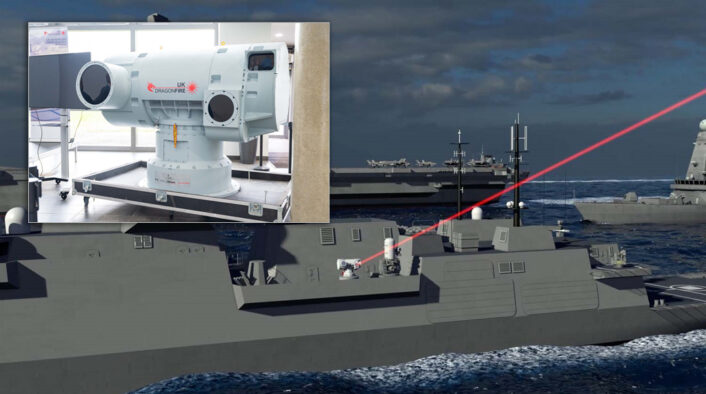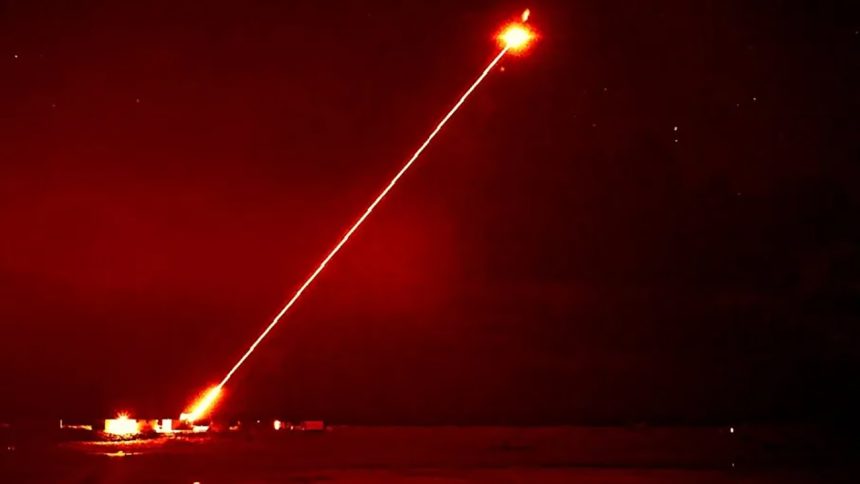The weapon will provide highly effective defence against drone and missile threats with just £10 a shot.
The UK Ministry of Defence announced that the new, cutting-edge DragonFire laser will be installed on Royal Navy warships for the first time from 2027. The roll out of laser weapons to the UK armed forces was initially expected in 2032, however a new defence procurement model which came into force this week allowed to make this happen much more quickly.
Able to fire at any target visible in the air at around £10 a shot and with an accuracy equivalent to hitting a pound coin from a kilometre away, the powerful DragonFire weapon will provide highly effective defence against drone and missile threats, said the MoD. This topic is particularly relevant today, as demonstrated by recent events in Ukraine and in the Red Sea, where missiles worth thousands of dollars have to be used to destroy small drones or cruise missiles which cost much less than the weapons needed to counter them.
The use of lasers would solve another big problem: the ammunition resupply. In fact, a laser directed energy weapon can enjoy an unlimited magazine of ammo, however it needs to have a reliable source of energy. This might not be a problem on a warship, but it could certainly be for a land-based mobile system.
🔥 New defence procurement reforms will see the DragonFire laser delivered into service five years faster than planned
The laser will be fitted on @RoyalNavy warships from 2027.
👇📽️ pic.twitter.com/Y1zo7HOZyu
— Ministry of Defence 🇬🇧 (@DefenceHQ) April 13, 2024
“Noting the quantity and varied sophistication of air and missile threats seen in the Southern Red Sea, we see a very relevant and current example of where laser weapons could provide an additional layer of defence to protect shipping, at a potentially much lower cost per shot and without the inherent onboard magazine and silo capacity constraints associated with interceptor missiles,” said Captain Matt Ryder, responsible for new capabilities as Head of Above Water Battlespace in the Royal Navy’s Develop Directorate.
For an instance,the HMS Diamond Type 45 destroyer, one of the British ships involved in operations in the Red Sea, is equipped with 48 vertical launcher system cells for Aster 15 and Aster 30 missiles, called Sea Viper in the UK. Each of these missiles costs between £1m and £2m and, once the missile stock is depleted, the ship needs to return to port or meet-up with a resupply ship. The cost of the targets being shot down is, instead, in the order of the tens of thousands pounds.
“Firing it for 10 seconds is the cost equivalent of using a regular heater for just an hour. Therefore, it has the potential to be a long-term low-cost alternative to certain tasks missiles currently carry out,” said the MoD after the tests campaign. “The cost of operating the laser is typically less than £10 per shot”.
The DragonFire demonstrator
This new UK sovereign capability is designed to provide short-range air defence and close-in protection for naval vessels using a range of different effects depending on the tactical scenario. These include identifying, tracking and deterring a potential threat by dazzling its targeting sensors, as well as damaging or even destroying the incoming threat.

DragonFire is led by the Defence Science and Technology Laboratory (Dstl), on behalf of the UK MoD, working with its industry partners MBDA (which leads the industry effort), Leonardo and QinetiQ. MBDA developed the command and control and image processing systems, Leonardo provided the system’s beam director and QinetiQ provided the laser source and developed coherent beam-combining technology .
It might sound impossible but the UK will very soon have lasers that shoot down missiles & drones at the speed of light.
How? Because we’ve reformed military procurement to speed up projects that could’ve taken decades, to urgently get the new weapons we need to defend Britain. pic.twitter.com/QswnQri0bf
— Rt Hon Grant Shapps MP (@grantshapps) April 12, 2024
Earlier this year, the UK MoD announced that the DragonFire laser directed energy weapon (LDEW) system achieved the UK’s first high-power firing of a laser weapon against aerial targets at the Hebrides Range. While the range of the weapon is classified, the MoD stated that the test demonstrated the ability to engage aerial targets at relevant ranges.
“This type of cutting-edge weaponry has the potential to revolutionise the battlespace by reducing the reliance on expensive ammunition, while also lowering the risk of collateral damage,” said Defence Secretary, Grant Shapp after the successful trial campaign.
The trials, which were conducted at the end of 2023, saw the LDEW system tested at various powers against representative air and maritime targets at varying ranges, altitudes and speeds. The DragonFire demonstrator is in the 50 kW-class, however the requirements for the final system have not been finalized yet. The Royal Navy previously sought the possibility to integrate a 150 kW-class laser on its ships.
A powerful laser weapon will be added to the #RoyalNavy’s arsenal…
The cutting-edge DragonFire laser will be installed on a warship by 2027, adding to an already potent array of air defence weapons countering growing drone and missile threats.
▶️ https://t.co/I29Q1mjX4G pic.twitter.com/101DcgTsYw
— Royal Navy (@RoyalNavy) April 12, 2024
With the decision to field the system from 2027, the DragonFire laser weapon system will rapidly develop from a demonstration programme to an operational capability for the Royal Navy. The next stages of this development, said MBDA in its press release, will include further live firings and the manufacture and installation of weapon systems onto Royal Navy platforms.
Meanwhile, officials from MBDA, Leonardo and QinetiQ confirmed to Naval News last month that they were working on ‘second-generation’ designs leveraging technology and techniques proven in the DragonFire prototype.









